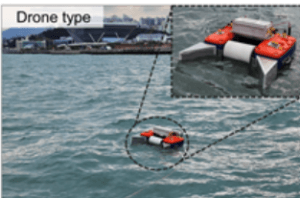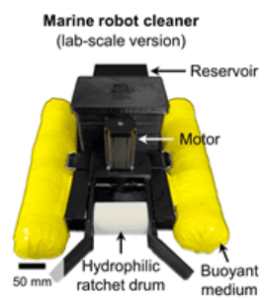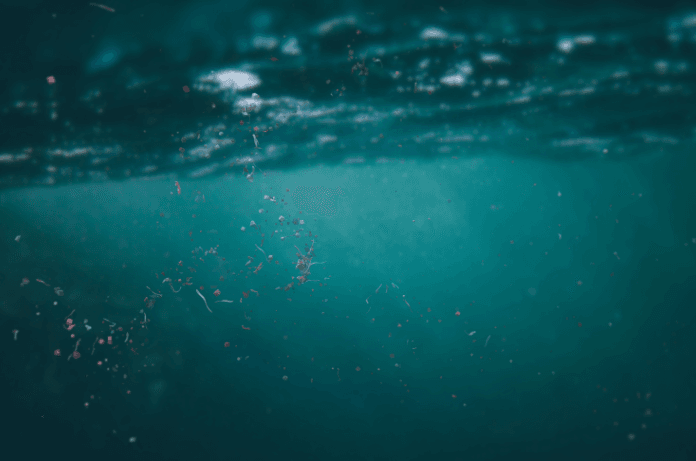Imagine walking along a beach, the sun casting a golden glow on the waves, only to be greeted by plastic bottles, foam fragments, and discarded fishing nets littering the shore. This is the reality of today’s marine environment. Plastic pollution is one of the most daunting environmental challenges we face. While massive cleanup efforts are underway, the problem is exacerbated by something far smaller: microplastics (MPs). These tiny pollutants, often invisible to the naked eye, are wreaking havoc beneath the surface, affecting marine ecosystems and human health. Their minuscule size makes them notoriously difficult to remove, presenting a unique challenge for traditional cleanup methods.
But science has come to the rescue with an innovative solution: capillary skimming using floating drones. This breakthrough technology, often deployed via hydrophilic ratchet structure can efficiently trap microplastics in water. The research was published in the journal Advanced Science. The hydrophilic ratchet mechanism of this floating drone captures the particles through controlled capillary action, making it possible to remove even the smallest pollutants from oceans, rivers, and lakes.
Let’s dive into this breakthrough and see how it’s changing the way we tackle marine plastic pollution.
The Growing Problem of Marine Plastic Pollution
Plastic production has surged dramatically over the last several decades. In the last 50 years, plastic usage has increased by 20-fold, leading to an equally alarming rise in plastic pollution.
Marine plastic pollution is classified into five categories based on size:
1. Mega-plastics, 2. Macro-plastics, 3. Meso-plastics, 4. Micro-plastics, and 5. Nano-plastics. Of these, microplastics (MPs) have captured scientists’ attention because of their small size, high mobility, and long degradation time. These particles are incredibly difficult to remove due to their tendency to float and disperse in the water.
The Challenge of Removing Microplastics
Traditional methods for removing MPs such as density-based separation and size-based separation have proven inadequate.

- Density-based separation uses techniques like flotation or elutriation to separate MPs such as polystyrene (PS), polyethylene (PE), and polypropylene (PP), which are less dense, from heavier particles like polyvinyl chloride (PVC) and nylon. Unfortunately, factors like surface fouling, bubble attachment, and organic matter aggregation complicate the process, making it inaccurate.
- Size-based separation, using filtration or sieving, is more common but fraught with problems. Filters tend to clog, particularly with biofilms in seawater, and dense membranes needed for smaller MPs slow down the process due to low permeability.
Thankfully, new methods are emerging that address these challenges head-on.
The Game-Changing Solution: Capillary Skimming
One of the most promising innovations for MP removal is capillary skimming using a hydrophilic ratchet structure of the floating drone. This method harnesses the power of the Cheerios effect – Yes, the same force that causes cereal pieces to clump together in milk!
How Does Capillary Skimming Work?
Picture this: a 2-mm expanded polystyrene (EPS) foam ball floating on water. The ball is surrounded by a concave water meniscus due to its low density (0.02–0.04 g/cm³). And creates an attractive force between the ball and a nearby hydrophilic plate. As the two water menisci overlap, the ball moves toward the plate, reaching speeds of up to 54 mm/s!
But the real magic happens when scientists introduce a ratchet structure. This structure uses alternating positive and negative tilting angles to enhance skimming efficiency. The ratchet’s hydrophilic surface traps MPs in a water bridge, making it easier to lift them from the water.
Dr. Seong Jin Kim and Myoung-Woon Moon of the Center for Extreme Materials Research at the Korea Institute of Science and Technology (KIST) have developed a new level of microplastic removal technology, offering a promising solution to this growing problem. They have developed a floating drone equipped with hydrophilic tooth structures that leverage surface tension to skim microplastics
Holding vs. Skimming: The Science Behind It
Researchers conducted two tests to understand the effectiveness of this method,
- Holding Test: An MP ball was manually placed on the plate to see if it would fall off due to gravity. The plate could support a weight of 1.0 ± 0.1 mN when gravity acted normally to the plate but only 0.4 ± 0.1 mN when gravity was parallel.
- Skimming Test: The plate was lifted to skim MPs directly from the water surface. Here, the ratchet structure of the drone’s ability to secure and lift MPs proved revolutionary.
Why the Ratchet Beats the Flat Plate
When lifting a flat plate, water drainage continues, reducing efficiency. The ratchet structure enables “meniscus cutting”. Here, the water meniscus is severed as the ratchet lifts. This innovative design prevents drainage, stabilizes the water bridge, and efficiently collects microplastics of various shapes and sizes.

Real-World Success: Continuous Recovery with a Ratchet Drum
Scientists took this method a step further by developing a rotating drum with a ratchet structure. This drum, measuring 60 mm in diameter and 50 mm in width, could continuously skim floating MPs from water.
During testing, the drum successfully recovered:
- 2–4 mm PE pellets
- 1–2000 µm PE particles
- EPS foam balls
- PP pellets and particles
Even as the drum’s rotation speed increased to 16 rpm, 80% recovery was achieved. This method proved effective across different environmental conditions, including waves, temperature changes, and wind.
Looking Ahead: A Bright Future for Our Oceans
The success of this hydrophilic ratchet technology marks a significant leap in our fight against marine plastic pollution. By integrating this method into marine robot cleaners, we can scale up MP recovery efforts. However, challenges like battery life remain. The good news? Researchers are exploring solar power and other sustainable energy solutions to keep these cleanup machines running.
Dr. Moon said that this technology isn’t limited to floating drones. It can also be integrated into stationary systems like water treatment filters in aquaculture farms and extended to household water treatment devices for everyday use.
Join the Battle Against Plastic Pollution
Our oceans are drowning in plastic, but innovative solutions like capillary skimming offer hope. By combining science, technology, and determination, we can tackle even the smallest pollutants threatening marine life.
Microplastics have attracted considerable concern due to their presence in tap water, bottled water, and natural bodies like rivers, lakes, and oceans. Traditional water treatment technologies struggle to filter out microplastics of different sizes and shapes and often face clogging issues. The removal of these tiny particles demands ultra-fine filter meshes, which increase pressure and significantly lower filtration efficiency. Moreover, these methods are ineffective in open environments such as lakes, rivers, and oceans, where microplastic contamination is on the rise.

